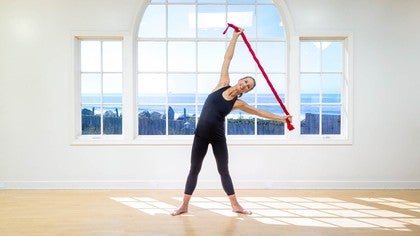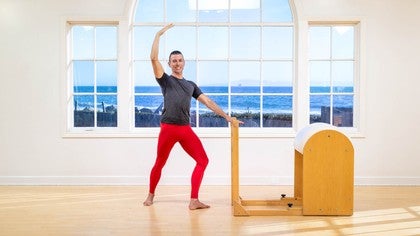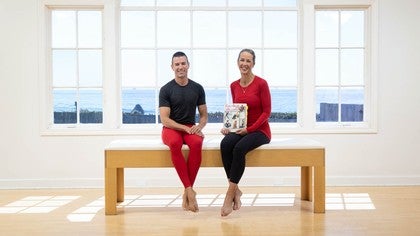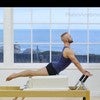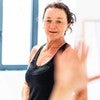Description
About This Video
Transcript
Read Full Transcript
Introduction
The Fletcher towel work came from a very humble beginning. Ron had no intention of putting his stamp on the Fletcher towel work and developing a technique. He was in his studio one afternoon and he was working with a client. And she was having a difficult time lifting her arms over her head. And he said, I saw 70 versions of wrong and not one version of right.And what he was referring to in terms of right was moving the arms from the back, moving with symmetry, and moving with an understanding with not only a spacial awareness of where the upper body was, but an awareness of where the movement was coming from. So, he picked up a towel. He had many towels in his studio. And he folded it in half, and then folded it again in half. And he twisted the towel up.
And he created basically a rope with a towel. And he said, madam, he would call his clients madam often, would you please lift the towel up over your head and create a straight line over the crown of the head? And the visual cue of the towel gave the client a sense of where she was moving from, creating the symmetry through the upper body. And that was the beginning of the Fletcher towel work was working with a client. It was basically his need as a teacher and a bit of frustration as a teacher.
So he used the towel as a prop. And then he began using the towel and engaging the back muscles by pulling the towel taut and releasing, just finding that engagement through the back, the connection through the upper body in various positions overhead. And then he began experimenting with range of motion through the shoulder girdle. So, very simple range of motion. And then eventually he started using the towel to stabilize the shoulder girdle and move more through the torso and move more through the upper body.
So, the towel served many purposes. Visual awareness, spatial awareness, that idea of engaging the arms into the back and finding the connection through the upper body that many people don't have, and the symmetry through the upper body. Beginning to work range of motion through the shoulder girdle. And then eventually to use the stability of the shoulder girdle to increase range of motion and articulation through the spine. So, this simple piece of cherry came from, again, a very humble beginning out of necessity.
And Ron developed the work over the course of four decades, over the course of 40 years. And he could teach a three-hour class just incorporating the towel work. Really, very much of a full body experience. Ron started with this very simple towel, twisting it again, and forming a rope. It became sort of a cumbersome tool.
As clients would release the towel it would become unraveled. And he didn't like messy, Ron never did messy. It was all about neat and clean. So, one of the students in class braided a white towel. And he liked the braid.
And it also gave the towel a bit of a bias pull. So, it was much more of an even engagement through the back. It also created more of an even grip for the hands. So, we went from the loose towel to a braided white towel. And then Ron really wanted his signature red to be incorporated with the towel work.
So, another student developed the red braided towel. And it was just the right shade of red. And we went through many iterations of red and many iterations of braided towel, and came up with just the right length, the right grip, the right shade of red. So, what I'd like for David to do, and I'll just set this off to the side, is demonstrate how we measure the towel. David would fold the towel in half and place the folded end of the towel at one end of the shoulder girdle.
And then place the loose ends at the other end. And, basically, what he's doing is just doubling the width of his shoulder girdle. We all have a different width. And what we want to do is hold the towel and double the width of the shoulder girdle. So, he'll demonstrate how to do that.
And then bring the towel down in front of your hips. And then David, if you would, just turn your back to the camera. And lift the towel up to chest height. And when we're pulling the towel, we want to think of pulling the towel evenly from the outside of one hand through the center of the back. So there's even force all the way round.
We're not pulling from the hands. We're not pulling from one muscle group. It's an even continuous pull of the towel. Again, to get that connection of the arms into the back. From here, I'd like for him to inhale and pull the towel taut.
And exhale, release. And you can also see how that connection to the breath connects him deeper into his shoulder girdle. And release, and again, evenly pull. Feel that initiation from the breath, and release. From here, he's working more through the center of the back, center of the trapezius, and release.
And then lift the towel up over her head. Lift it up over the crown of the head. And press it down to the chest. And feel that range of motion come from the back, not from the upper shoulders. And again, from the sides of the back, feel that length, and down.
And one more time. Lift it up over the crown of the head, and hold it there. Again, we want to feel that even connection from the outside of the arm. Now he's working more from the lower trapezius and coming up. So, there's that even energy field.
And inhale, pull, and exhale, release. Pulling from the sides of your back, and your breath, and release. Try to keep the towel more over the crown of the head. And pull, and release. Again, just finding that connection of the arms, from the arms into the back, and release.
And then take a full breath to press the towel down right in front of the hips. Now, here is the line that we're working, or the chain of motion that we're working. Inhale, pull, and exhale, release. Opening into the sides of the body, feel that expansion across the back, and release. Two more times.
And just four pulls on each position is enough to warm up the back and find that connection. One more time, pull, and release. And then keep that expansion across the chest, across the back. And lower the towel down. Inhale, glide the shoulders up.
And pull the shoulders down. One more time, lifting up and pulling down. Thank you, David. So, the towel again started, the towel work, Fletcher towel work started from a need, a need to add a visual cue to a very simple movement. And from there it developed.
And Ron developed the Fletcher towel work over the course of four decades, oftentimes, taking a piece of movement from one workshop to another. And it became a signature part of the Fletcher work. It was introduced, the Fletcher towel work, in Every Body is Beautiful as one of the 12 wake up steps, which is also included in the segment of the workshop.
Movement
Hi, I'm Kyria, and I'll be teaching an intermediate towel work class, Fletcher towel work class based on Ron's introduction of the work, the towel work in Every Body is Beautiful. So, we'll start with the feet together, legs together.Think of narrowing the hips, drawing the belly to the spine. And begin by inhale, lifting your shoulders up. And press your shoulders down. And, again, breathing in through the nose and out through the mouth. Inhale, lift up, and exhale down.
One more time, draw the shoulders up. And place the shoulders on your back. Plie, reaching forward and press tall. And, again, reaching forward. Think of taking up your vertical space.
And, again, reaching forward, lengthening up taller than before. One more time, reaching forward, and lengthen up. And then hold that plie, and gently pulse it down. Two, three, four, five, six. Think of peeling away from the wall behind you.
Rounding over towards the floor, placing the fingertips on the floor. And exhale, extend the legs. Inhale, bend, exhale, extend. Think of drawing the belly to the spine to press those hips up to the ceiling. Two more times, bend, and extend.
One more, bend, and then hold that extended position. And pulse the head to the floor. Pulse, two, three, four, five, six. Take a hold of the center of the towel. And roll up bone by bone, stacking the lumbar spine, thoracic spine, cervical spine.
And think of floating the head straight up to the ceiling. And then let's fold the towel in half. And place the folded end of the towel at one end of the shoulder girdle. And then come across the shoulder girdle. And then just double the width of your shoulders.
Bringing the towel down in front of you. Again, draw the shoulders up. Place them down, and inhale. Draw the shoulders up, and place them down. And beginning with a breath, take a deep breath in, opening to the sides.
And exhale, close. Again, breathing in through the nose, out through the mouth. (breathes deeply) Breathing evenly into the sides of the body. And exhale, close. Then, take a full breath to pull the towel taut, pulling from your back. And let's inhale, lift the towel up to chest height.
And think of slicing through the air, growing taller as you press down. Inhale, lift up to chest height. And press down to lift up. Let's do that two more times. Inhale, lift, exhale, press down into your back.
One more time, inhale up, and hold the towel at chest height. Pulling the towel taut from the back. And release, reaching those elbows wide to the sides, and release. Think of the breath pulling the towel taut, and release. Let's do that one more time.
Inhale, pull, and exhale, release. Draw the towel down to the hips. And pull the towel taut from here. Inhale, pull, exhale release. And, again, pull, and release.
Pulling evenly from the back, deep breath in. And release, one more time. Inhale into the sides of the body, and release. Bring the towel to chest height. And then draw the towel up overhead.
From here, draw the shoulders up. And wrap the shoulders down your back. Inhale, glide the shoulders up. And think of wrapping those armpits forward. Two more times, inhale up.
Exhale, pull down, one more time. Inhale up, and draw the shoulders down. And then pull the towel taut, and release. Pulling from the back, pull, and release. And again, pull from the back.
Try to pull evenly. Towel's right over the crown of the head. Pull and release. And from here pull the towel taut. And then just draw the towel down.
And make sure you're touching the center of the crown of the head. Reach it up from your back. Inhale, pull, and up from the sides of the back. Two more times, inhale, pull it down, and lengthen up. Last time, pull down, and up.
Inhale, towel to the chest. And exhale, press it all the way down. Take another deep breath in to widen the chest, widen the back. Keep that lift as you lower the towel down, circling the shoulders up around and back. And, again, up and around, two more times.
Placing the shoulders, lengthening the sides of the neck. One more time up, and around. Now, let's pull the towel taut again. Keeping the towel taut, bend the legs. Plie as you lift the towel up to chest height, press down.
And, again, adding a play to this simple movement. Enter your range of motion. And, again, plie, lift and press. Inhale on the plie, hold it here. And pulse the plie.
(Kyria breathes deeply) Two more times with a double breath. This is percussive breathing. Inhale, lift up overhead. And exhale all the way down. Now, let's take a big breath to lift the towel up.
And exhale, press. And, again, inhale, lift. And growing taller as you press down. Let's do one more time. Big breath in through the nose.
And then pull the towel taut. And release it down. Big shoulder roll up and around. And one more time, up, and around. Let's divide this space from the hips to overhead into pieces.
We'll take it in two breaths up, two breaths down, three breaths up, three breaths down, four. And let's see if we can work up to five. Pull the towel taut at the hips, opening the chest. Find that connection into your back. And let's start with two even breaths up, even breaths down.
Ready, and... (breathes deeply) And threes. (breathes deeply) And fours. (breathes deeply) Going into fives. (breathes deeply) And, again, big breath in to expand the chest. Keep that lift through the chest, and lower the arms down. Circling the shoulders up around and back. And, again, up, around, and back. If you think about it, the first mat work exercise is the 100.
And, classically, it's taught five breaths in, five breaths out, which is really challenging for most of our clients and students. They don't have the lung capacity. They don't have the breath awareness, the movement connection to the breath. So what we do in the Fletcher work is we start generally with choose. Work up to threes, work up to fours, work up to fives.
And it's conditioning the body to learn how to breathe expansively. There's a certain endurance involved in breath. And the towel work helps with that and really helps us understand the spatial awareness of the movement of the arms, coupled with the filling and emptying of the lungs. The next series we'll go through is called pulse to W. Again, pull the towel taut.
And whenever the towel is straight it's taut. So it's not an ornament. It's something that we're actually working. Lift the towel up to chest height. And image the arms forming a W shape when seen from above.
Pull the towel into your chest, keeping the elbows on an even shelf. Exhale, lengthen forward from your back. And, again, feel that breath initiate the movement. (Kyria breathing deeply) One more time forward to the chest. And press out from the back.
And then draw the towel into the chest. And then rotating the shoulders down and back. Again, rotate the elbows and shoulders down. There's that W shape. And back two more times.
Down, feel that connection into your back. And lengthen forward, one more time, rotate down. And then from here press the towel up overhead. And let's pull the towel down to the chest. Think of gliding up and down that wall behind you, and pull.
Inhale, lift up without lifting the shoulders. And pull down from your back, one more time. Inhale, lift up, and pull to the chest. Now, let's pull to the upper back. Inhale, lift, and pull to the upper back.
And, again, lift up and pull down. And two more times. Lengthen from the sides of the body, and pull it down. Last time, up, and to the upper back. This time let's alternate, lifting up, and pull to the chest.
Lengthen up, very simple movement, but it really gets those arms connected, into the back. Gets the scapula connected down the back. And one more time up and upper back. And lower the head down, stretching the back of the neck. And let's add a cervical movement to this.
Inhale, lift up, and expand the chest. And lengthen up, and lengthen through the back of the neck. And again, inhale up, exhale, pull to the chest. And up, and upper back. One more time, lift up, open the throat.
And lengthen through the back of the neck. And this time lift up. And press the towel all the way down. Pull it taut, expand, and releasing. You should feel a lot more circulation through your shoulders, upper back, more length through your neck.
Ideally, a little more upright posture. One more time up, and circle around. The next movement is overhead to U. And this movement involves going from a closed chain environment, closed chain would be pulling the towel taut to an open chain, where we're still maintaining that position through the scapula. But releasing the tension on the towel.
So, pull the towel taut. Again, a lot of taut towel pulls. And take a full breath to lift the towel up overhead. And pull the towel a little tauter. Then, from here place the towel in a U shape on your back.
So, you're forming one straight line from elbow to elbow. Inhale, pull taut, exhale to that U shape. Two more times, breathing in through the nose, pull taut. And down into that U shape. One more time, pull, and to the U.
And then from here open through the upper back, stretching the back of the neck, draw the elbows to meet. And then open the chest. And, again, open through the scapula, upper back. Again, keeping the elbows on that same shelf. And open the chest.
And open the back. And open the chest. And then putting those two simple movements together, pulling the towel taught overhead, keeping that same connection in your back as you draw the towel down to a U. And then open through the back, breathing in. And open the chest. (breathes deeply) One more. (breathes deeply) And then from here, take a full breath to lift the towel up overhead.
Draw the shoulders up. And pull the shoulders down. Let's lift all 10 toes up, and pull the legs, the feet into a turned out position. Keeping the towel right over the crown of the head, reach the hips over to the right. And try to take the shoulder girdle evenly off center.
Pull the hips back to center. And, again, hips over to the left, and a full breath to pull the hip center. Up and over to the right a little bit further. And pull back to center. And one more time, over to the left with the hips and center, going side to side.
Up and over. (breathes deeply) Try to initiate this movement from the pelvis, from the hips. And upper body just follows. (breathes deeply) Two more times. (breathes deeply) Holding this side bend, pulse the hips a little bit further. (breathes deeply) With a double breath. (breathes deeply) Up, and reach the hips over to the right, pulsing from the hips. (breathes deeply) From here, contract the upper body forward. And press the hips to the left. And, again, full breath around and hips to the right. And contracting, and to the left, one more time.
Upper contraction, hips to the right. Pull the body up through center. And press the towel down in front of you. Again, circle the shoulders up and around. One more time up, and around.
And that's the lateral hip stretch. Let's take this into posterior range of motion. So, we'll draw the feet back together. And, again, draw the belly to the spine. Pull the shoulders down the back.
Anything that happens from the hips to overhead would be considered anterior range of motion through the shoulder girdle. Anything that happens behind the head, and I'm just demonstrating, so we're gonna ease into this movement would be considered posterior range of motion. So, we'll start with a towel. Up overhead, right over the crown of the head. And then just inhale, reach back as if you were tapping the crown of the head.
And then exhale, lift up overhead. And again, inhale, reach back, and touch the crown of your head. And up overhead. And as you do this try not to sway the body forward. So, keeping the body perfectly still, reach back, and up to the ceiling.
One more time, reach back, and hold this position. And gently tap it down. Tap, two, three, four, five, six. And pull into that W shape, and press out. And, again, pull into the W, and lengthen out.
And pull, and try to stretch out long through the hands, long through the knuckles, opening the front of the shoulder. And stretch out, lifting up. And press all the way down. Let's take that a little bit further. Inhale, lift up, let's exhale.
Reach it back to the base of the head. This time inhale, lift up. Exhale, reach it back. Two more times, breathing in. (breathes deeply) One more time, but try not to force it, and down. And, again, gently pulse it down.
Two, three, four, five, six. And lift up, and down to the hips. A little bit further, inhale, lift. And reach it back to the shoulder girdle. Inhale, lift, and place it to the front.
Think of a shelf going straight through the chest. And you're tapping that same shelf to the front (exhales deeply) and to the back. (exhales deeply) Two more times up, and place, and up, and reach. Last one, up, and place, and lift. We call this closing the gap. And pulse, two, three, four, five, six.
And pull it in, and extend those arms down behind you. Inhale, lift up to the top of the pelvis, the ASIS. And then as you lower the towel, wrap the towel around the hips, reaching the elbows forward. Take a full breath to open the chest, lifting to the top of the pelvis. And then wrap the towel, rounding through the upper back.
And, again, full breath to expand. (breathes deeply) Full breath to contract into that plie. One more time, full breath to open the chest. And contract it down. Let's take it up a little bit further. Full breath to lift up to the base of the ribs.
And then simply lower it down. And lifting up to the base of the ribs, and down. Let's do that two more times, expanding through the front of the shoulders and the chest. This time lift up, and hold it up there, tapping up. (Kyria breathing deeply) Watch that you don't hyperextend the elbows.
Last set, and lift up a little bit higher. And then wrap the towel around the hips. And, again, come up to the middle of the shoulder girdle. Find that same shelf, and lower down. And lifting up, opening through the front of the shoulders, and down.
You never want to force this movement. Up, only work within your range. And lift up, and hold that lift. And pulse up, two, three, four, five, six. Lift up a little bit higher.
And, again, open through the back. And let's go into full range of motion. Let's bring the towel up and press it down, starting in front of the body. If you don't have full range I'll show you the modification first. Inhale, lift up.
You'll work to your range, and then simply bend the elbows, extend the arms, and bring the towel down. Same thing on the way up, coming up, bend, lift, and down. We want to work the stretch, but we don't want to force it. Inhale, lift up, and exhale. Reach back, going slowly.
And, again, inhale, lift, and exhale down. Try to feel the breath, move the towel. (Kyria breathing deeply) Two more times, inhale on the lift. Exhale, reach back, and up, and around. One more time, inhale, lift.
Exhale, stretch back. And lift up, and around. And then pull the towel taut, feel that expansion, hold onto it. And lower it down. And, again, circle the shoulders up and around.
And one more time, up and around. From here, we'll go into more spinal movements. We'll go into some rotational work, some lateral flection work, and a lot more trunk mobility. Lift the toes up and come to a turned out position. And then rotate to parallel.
And, again, turnout, parallel. And third rotation come out. This would be a second position. So, if you place the towel right at one shoulder the towel should end up right inside the heel. Pulling the towel taut at the hips, let's lift the towel up overhead, just taking some air in.
Exhale, press it down. And, again, lift it up, and press it down. Two more times, lifting up and down. And lifting up, and draw the shoulders down your back. Lateral flection or side bending.
Lift up out of the hips and over to the right. Lift up, and set the shoulders down. Up out of the hips, over to the left. Lift, and set the shoulders a little bit further. And over, keeping those hips still.
And set the shoulders down. Up, and over to the side, lift and shoulders down. Going side to side up and over to the right. And lift, and to the left. And up, and over.
Try to keep the space between the head, the arms and the towel uniform as you go side to side. And a little bit further up and over to the left. And this time hold the side bend over to the right. And then just draw the towel across the body. We call this the towel sweep.
And open to the side. And, again, press across the front of the body and deepen that side bend. Again, across, opening the chest, deepening the side bend. One more time, across, and open. Lift up, and over to the left.
Same thing, press across the body. Try to keep the towel perpendicular to the floor of the ceiling across. And open, and again, open a little bit further. One more time across and open to the side. Lift up, and press down again.
Deep breath in, expanding the chest. And lower the towel down. Just circle the shoulders, and up, and around. We'll go into the rotation patterns now. So, again, standing in a second position.
Pull the towel taut. And lift the towel up to chest height. So, think of keeping the space, we call it a solid space, between the towel, the chest, and the arms. So, we don't want to change that space. We want to take the space with us.
Let's lift up out of the hips. And rotate the body around to the right. And then find that same lift to pull you back to center, using the breath to lift us up and around. Keeping the hips still, lift up, and pull back to center. One more time, up and around to the right, taking it a little bit further.
And pull back to center. And one more time, up and around to the left. And come back to center. Adding onto this simple movement, up and around to the right. Inhale, stretch the sides of the body.
Exhale, center, and down. (Kyria breathing deeply) And then keeping the towel up overhead, draw the shoulders down. Rotate the body around to the right. And come center, to the left, and center. One more time, up and around to the right, and center.
Last time to the left, center. Going side to side. (breathes deeply) Try to keep the hips still. And take it a little bit further each time. Four more. (breathes deeply) And come center, and press the towel down. Pull it taut, and release it.
One big shoulder roll, and down. Now, we'll take this into a couple of more advanced patterns. The first is called Xs and Os. Let's just take some air in, inhale, lift up, exhale down. And lift up, and exhale down.
This time inhale, lift up, exhale into a deep plie. Take a full breath to contract forward. And roll up through the spine as you lengthen out through those legs. Lift up, and plie, contracting forward. And press down to lift up.
Let's deepen that contraction. Inhale, lift up, all the way over to the floor. Take a full breath to extend the legs, lengthen. And another breath to roll up through the spine. And, again. (breathes deeply) And all the way up to that starting position.
One more time, inhale, lift, and plie, contracting forward and lengthen the legs. And roll up to the starting position. Pulling the towel taut, and release it down. The next piece also is more advanced. It's called the hallelujah circle.
And Ron developed this piece at a workshop I was at in Vail, Colorado. And what he often did is he would work a piece of movement from one workshop to the next, until he finally said it spells mother, which means he had a keeper. So, this is the hallelujah circle. It starts also in a second position. We'll start with a towel up overhead.
So there's that X position. Place a hand at one hip. And then open the chest, stretching the shoulder to the back. And then lift back up overhead. Inhale, open, exhale, lift.
It's like you're winding up the movement. And lift up, and open. And then take that a little bit further. Inhale, open to the right. And stretch to the side, coming up through center, around the other side, center, and up.
Hand to the hip. And, again, over to the right. Lift up, and around, and lift up. Take it to the other side. Open the chest and reach.
Center, around, down, and lift. (Kyria breathing deeply) And then let's make that flow a bit more. Right hand to the right hip. (breathes deeply) Left hand. (breathes deeply) And all the way down in front. With the more advanced pieces there's more flow to the movement. There's more three-dimensional movement to the movement And it really feels wonderful to the body to do that very circular movement.
As Ron said to me one time, I was studying different forms of movement outside of our Fletcher box. And he said, Kyria, it's all in here. You just need to explore the edges and the roundness of it. So, this is a very round piece of movement coming from a very stable center. The next piece is called take a bow.
Again, this is a very three-dimensional piece of movemet. It does involve posterior range of motion. So you want to work the simple posterior range of motion before you go into this piece. This starts in a plie and in a contraction, it's an upper contraction. And you want to think of hovering your body, much like we do in rolling like a ball up and around three-dimensionally.
So, from here, let's take a full breath to open the body and extend the legs to the right. And then come back into that deep contraction. And a full breath to open to the left. And as Ron often said, think of arriving at the same time. So the upper and lower body arrive at the same time.
And then deep contraction to come forward. And, again, full breath to press up into that side bend. And contract forward. And then take a full breath to open. And let's from here extent and stretch the front of the shoulder, coming back to the side bend.
And reach back to the side bend. Let's do that two more times. Open, and back to the side bend. Last time, open and stretch, and to the side bend. Then, coming back into your plie.
Full breath to open to the left, and stretch. You'll notice that one shoulder's tighter than the other, unless you're completely balanced. And back to the side bend. Two more times, open and stretch, and back. Last time, stretch a little bit further.
Reach back to the side bend and into the plie, taking one more progression to this movement. Full breath to open to the right. Full breath to open to the back. And then draw the towel around the body. Come into a deep contracted plie.
And then just unwind that position to the back and to the side. And then back to the starting contracted position. Full breath to open to the side. Reach to the back. And a deep contraction forward.
And then open to the back, to the side, and forward. Breathing into the piece, full breath. (Kyria breathing deeply) And then lengthen up, rolling up through the spine. Circle the shoulders around, up and around. Then, draw the feet to parallel.
Turn out, coming all the way back to that centered stance. And let's the pull the towel taut. Lift the towel back up to the chest. And think of the towel almost like a propeller. And then just rotate one arm up, and center.
We call this the windmill. (breathes deeply) Keeping the shoulders down, going from right to left. (Kyria breathing deeply) Last set, and come center. Lifting up, again, pull the towel taut. Draw the towel down. And you're ready to go.
Thank you very much for joining me for this class.
Pilates Legacy Project: Every Body is Beautiful
Comments
You need to be a subscriber to post a comment.
Please Log In or Create an Account to start your free trial.
